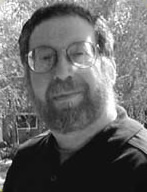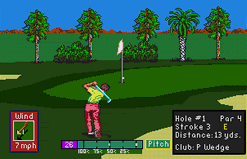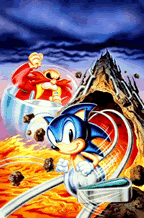Lee Actor has been around the gaming industry for almost thirty years and has worked on everything from the Atari 2600 to coin-ops and PCs. As a founder and programmer with Sterling Silver Software (later renamed Polygames), he achieved great success on the Genesis, where his company did  Electronic Arts’ seminal golf series PGA Tour Golf, as well as several games for companies like Accolade and Tengen. In all, Actor’s company did more than half a dozen full 3D polygonal titles for the Genesis, which is a pretty remarkable feat when you consider that the console isn’t designed for it.
Electronic Arts’ seminal golf series PGA Tour Golf, as well as several games for companies like Accolade and Tengen. In all, Actor’s company did more than half a dozen full 3D polygonal titles for the Genesis, which is a pretty remarkable feat when you consider that the console isn’t designed for it.
Actor left the industry in 1999, and he now concentrates on composing orchestral music. He’s released several albums and has been the composer-in-residence for the Palo Alto Philharmonic since 2002. Though he’s no longer active in the video game industry, Actor’s legacy continues to influence programmers and gamers today.
Sega-16 recently chatted with Mr. Actor over the phone, and he shed some light on the inner workings of several famous Genesis titles, like PGA Tour Golf and Sonic Spinball.
Sega-16: From Videa to Bally Sente, you have an extensive resume of programming in the gaming industry. When you and Dennis Koble formed Sterling Silver Software (renamed Polygames in 1992), how did you guys end up working on the Genesis? Your previous work had been mostly computer and coin-op.
Lee Actor: Well, back then it was mostly coin-op. Back in the Bally Sente days, a colleague of mine, Dennis Koble, and I decided to start our own company – this is probably about 1988. The company was originally called Sterling Silver Software, but we ended up changing this later because there was a company called Sterling Software that didn’t like that. They thought their customers would be confused, even though they were in a completely different field, so we changed the name to Polygames.
So Dennis and I started, and the first thing we did with Sterling Silver Software was PC. We did PGA Tour Golf for Electronic Arts, and I guess the Genesis was starting to pick up market share. Basically, Dennis and I tired to convince EA that they should do a Genesis version. Right around that same time we were doing work for Atari under Tengen, their home label. They were interested in us doing Sega Genesis versions of their coin-op games, so we did a number of those. So, I think the first two titles we did were PC, and we did one for Accolade, and then we did Genesis titles for a number of years. For a long time that was all we did.
Sega-16: You once stated that PGA Tour Golf was Polygames’ breakthrough title, and it helped establish the company’s relationship with Electronic Arts. Trip Hawkins is a major sports fan, so you guys must have really impressed him. What was his initial reaction when he first saw the game in action?
Lee Actor: Well, as things often happen, it’s not all the same from beginning to end. We worked on PGA Tour Golf for well over a year; it might have been closer to two years, actually, and for the… let’s say, 75% of the development, Electronic Arts was not a big fan of the product, mostly because of a the fellow who was the producer there. It just became one of those projects that could never come to a completion. We would do this and that, this feature and that feature, and then the producer would come back with six more things he thought should be different. It wasn’t until Don Traeger became the producer of the project that it finally began to work out.
Sega-16: Compared to other Genesis golf titles of the era, like Arnold Palmer Tournament Golf , PGA Tour was a major advancement in both presentation and gameplay. What did you specifically set out to create, as compared to the competition?
Lee Actor: Ah, it might not have been in there right at the very, very beginning. If not, it was soon after we started. They did get the PGA license – that was EA’s contribution, and I think it made a lot of difference with the product. You had the actual golfers and courses. I think that was one of the things that maybe separated it from some of the other golf products of the time. The other thing I would say is – and it might sound kind of silly from today’s perspective – the fact that we had a version in real 3D, especially on the putting. That wasn’t something that you often saw. The fact that we even tried 3D was a challenge in and of itself. So, you know, adapting a 3D game to the Genesis, which which did not even have a bit map, was not easy.
Sega-16: Polygames ported several games to the Genesis for Tengen. Why would Atari farm out its arcade titles to a third party?
 Lee Actor: Well, Atari coin-op and Atari consumer were always completely separate. There was basically no overlapping. In fact, for a few years there was a lot of competition and a lot of hard feelings. So around 1989 or 1990, somewhere around there, there was a lot of demand for these types of games (Genesis games). They did some things in-house, but they basically didn’t have the resources to do everything they wanted to. We knew the guy in charge of 3rd party development for consumer products, Steve Calfee, who went to school with Dennis and was a long-time coin-op veteran. So, the way this worked was that we had a reputation of producing high quality products on time, and so we had a lot of business going on.
Lee Actor: Well, Atari coin-op and Atari consumer were always completely separate. There was basically no overlapping. In fact, for a few years there was a lot of competition and a lot of hard feelings. So around 1989 or 1990, somewhere around there, there was a lot of demand for these types of games (Genesis games). They did some things in-house, but they basically didn’t have the resources to do everything they wanted to. We knew the guy in charge of 3rd party development for consumer products, Steve Calfee, who went to school with Dennis and was a long-time coin-op veteran. So, the way this worked was that we had a reputation of producing high quality products on time, and so we had a lot of business going on.
Sega-16: True. Polygames did a total of seven polygonal games for the Genesis, including Hard Drivin’ and Steel Talons for Tengen. How on earth did you make the console do manageable 3D? It had no hardware for that!
Lee Actor: You’re right, it had no hardware for that at all. Well, let’s just say that Steel Talons especially was extremely challenging. I mean, you have some nice hardware in the coin-op, of course. On the Genesis, we didn’t have the same frame rate as the coin-op did; it ran pretty slow. The game was there, but you know, it was choppy. I remember sometimes that the frame rate would drop below ten (per second). But basically what we did for the Genesis 3D stuff, well we had our 3D engine code, and we interpolated between the output of that code and the Genesis hardware on a translation level. We ran our 3D code as if we were drawing into a bit map, and then we had another level that basically translated that bit map into what the Genesis used. But you’re right. It was absolutely not designed or even ever conceived, I’m sure, to do what we were doing.
Sega-16: The original Pit Fighter turned out to be quite an arcade hit for Atari. What challenges did you face porting it to the Genesis? Most obvious is the elimination of the scaling camera.
Lee Actor: Wow, I’m trying to remember, as that was quite a while ago! That game actually sold quite well for us. We were able to get most of the game in, and I frankly don’t remember much about that game camera, but I do remember that there was no way we would be able to do that without any special hardware. I mean, even if we could have used the Genesis hardware to do that, it still would have required way more memory than we had. We would have had to include multiple versions of all the graphics,, and there was just no way that was going to happen.
So you’re right about that, but aside from that, we did get most of the game in.
Sega-16: Why wasn’t Pit Fighter 2 ever released?
Lee Actor: I don’t know… was that never released? (laughs) I remember finishing it! Honestly, I honestly don’t remember, but you’re probably right.
Sega-16: Many people don’t know just how integral Polygames was in the making of Sonic Spinball. I’ve heard that Roger Hector called on your company because he needed the game done quickly. How did the scenario actually play out? When did Hector contact you?
Lee Actor: Roger is an old friend of both Dennis and mine, and I first started working with him back in about 1982. What happened was that Roger was the head of the Sega Technical Institute, and Sega of Japan was working on the next Sonic game… I think it was number three? Sometime in the spring they realized that they weren’t going to have it ready for Christmas. Now, the way this usually works is that you have to have a major product for Christmas, which is where most of your sales come from. So, Peter Morawiec of STI had done a Sonic game design, but they didn’t have the resources in-house to get it done. Roger called us and said that it was an emergency product that they needed yesterday, and that they’d put any kind of resources and money that they had to get it done.
Basically, we programmed most of it; we managed all of it, and we did what would normally take about twelve months in a normal development process and did it in about four and a half to five. We had exactly one meeting with Sega and the STI. They did assign a couple of programmers to help us out. In fact, STI put them up in a hotel so they wouldn’t be distracted by other people at work. We designed the software structure, did the bulk of the programming, and we also did it in such a way so that we could hand pieces off to other guys on the project. They did do a couple of levels, I think… I mean I don’t exactly remember the exact extent of their involvement (Ed. note: read our interview with programmer Steve Woita to find out!). We designed the software in a modular way so that other programmers could work on levels independently, and we were then able to hook it in and integrate their work to the rest of the game. STI provided the art and sound. Of course, in all the projects that we worked on we had a third party take care of the art. Dennis and I did the software design, the bulk of the programming and the project management.
The game went out on time, and I wouldn’t say it was the best game we ever did, because of the time frame. So from my perspective, yeah, we were definitely involved, to make an understatement — we were primarily responsible for bringing Sonic Spinball into existence as a top-selling product.
Sega-16: So you and Dennis had little interaction with STI members?
 Lee Actor: We didn’t have much interaction with anybody. I started working, and I don’t exactly remember the details of how it was organized, but I do remember that that summer I left my house one time. We worked seven days a week, no breaks. We didn’t do anything else, of course.
Lee Actor: We didn’t have much interaction with anybody. I started working, and I don’t exactly remember the details of how it was organized, but I do remember that that summer I left my house one time. We worked seven days a week, no breaks. We didn’t do anything else, of course.
Sega-16: You pride yourself on producing bug-free code, and this was quite hard to do with Sonic Spinball because of its short development cycle. How do you feel about the final product in terms of overall quality?
Lee Actor: Well, like I mentioned to you, I wouldn’t say that it was the best work we’ve ever done. I still think that PGA Tour Golf III was our best work. But it’s a playable game… I think it’s a fun game. Obviously, some people don’t think it’s a very good game, and there are others who find it a lot of fun. We could probably argue about it, but like I said, you have to take into account the development time. It was a pretty complex game as well; it was a big game. I would give it a “B” as far as the game quality is concerned. As a product, I’d give it an “A++” because they sold a lot of them.
Sega-16 appreciates Mr. Actor taking the time to chat with us!

Pingback: Megadrive Hard Drivin’: A Defence – Fatnick Industries